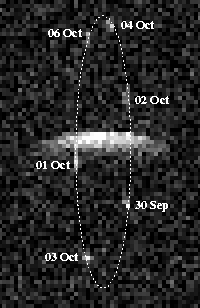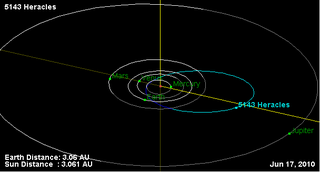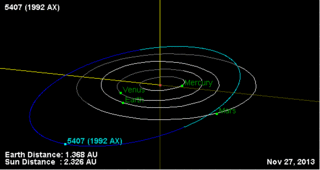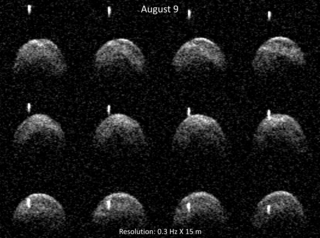2063 Bacchus, provisional designation 1977 HB, is a stony asteroid and near-Earth object of the Apollo group, approximately 1 kilometer in diameter. The contact binary was discovered on 24 April 1977, by American astronomer Charles Kowal at the Palomar Observatory in California, United States. It was named after Bacchus from Roman mythology.
2006 Polonskaya (provisional designation: 1973 SB3) is a stony Flora asteroid and asynchronous binary system from the inner regions of the asteroid belt, approximately 5 kilometers (3.1 miles) in diameter. It was discovered on 22 September 1973, by Soviet astronomer Nikolai Chernykh at the Crimean Astrophysical Observatory in Nauchnij, on the Crimean peninsula, and later named after Ukrainian astronomer Elena Kazimirtchak-Polonskaïa. Its one-kilometer-sized satellite was discovered by an international collaboration of astronomers in November 2005.
3309 Brorfelde, provisional designation 1982 BH, is a nearly spheroidal, binary Hungaria asteroid from the inner regions of the asteroid belt, approximately 4 kilometers in diameter. It was discovered on 28 January 1982, by Danish astronomers Kaare Jensen and Karl Augustesen at the Brorfelde Observatory near Holbæk, Denmark. It was named for the discovering observatory and the village where it is located.

(185851) 2000 DP107 is a sub-kilometer sized asteroid, classified as potentially hazardous asteroid and near-Earth object of the Apollo group that is notable because it provided evidence for binary asteroids in the near-Earth population. The PROCYON probe developed by JAXA and the University of Tokyo was intended to flyby this asteroid before its ion thruster failed and could not be restarted.
6084 Bascom, provisional designation 1985 CT, is a binary Phocaea asteroid from the inner regions of the asteroid belt, approximately 6.3 kilometers in diameter. It was discovered on 12 February 1985, by American astronomer couple Carolyn and Eugene Shoemaker at Palomar Observatory in California. It is named after American geologist Florence Bascom. Its satellite measures approximately 2.3 kilometers and has an orbital period of 43.51 hours.
4029 Bridges, provisional designation 1982 KC1, is a stony asteroid and binary system from the middle regions of the asteroid belt, approximately 8 kilometers in diameter.

65803 Didymos is a sub-kilometer asteroid and binary system that is classified as a potentially hazardous asteroid and near-Earth object of the Apollo group. The asteroid was discovered in 1996 by the Spacewatch survey at Kitt Peak, and its small 160-meter minor-planet moon, named Dimorphos, was discovered in 2003. Due to its binary nature, the asteroid was then named Didymos, the Greek word for 'twin'.

1338 Duponta, provisional designation 1934 XA, is a stony Florian asteroid and synchronous binary system from the inner regions of the asteroid belt, approximately 7.8 kilometers in diameter.
1453 Fennia, provisional designation 1938 ED1, is a stony Hungaria asteroid and synchronous binary system from the innermost regions of the asteroid belt, approximately 7 kilometers in diameter. Discovered by Yrjö Väisälä at the Turku Observatory in 1938, the asteroid was later named after the Nordic country of Finland. The system's minor-planet moon was discovered in 2007. It has a derived diameter of 1.95 kilometers and is orbiting its primary every 23.55 hours.

5143 Heracles, provisional designation 1991 VL, is a highly eccentric, rare-type asteroid and synchronous binary system, classified as near-Earth object of the Apollo group, approximately 4.8 kilometers in diameter. The asteroid was discovered on 7 November 1991, by American astronomer Carolyn Shoemaker at Palomar Observatory in California, United States. It is named for the Greek divine hero Heracles. It has an Earth minimum orbit intersection distance of 0.058 AU (8.7 million km) and is associated with the Beta Taurids daytime meteor shower.
7088 Ishtar, provisional designation 1992 AA, is a synchronous binary asteroid and near-Earth object from the Amor group, approximately 1.3 kilometers in diameter. It was discovered on 1 January 1992, by American astronomer Carolyn Shoemaker at the Palomar Observatory in California. The relatively bright asteroid with an unknown spectral type has a rotation period of 2.7 hours. In December 2005, a 330-meter sized satellite was discovered, orbiting its primary every 20.65 hours.
5905 Johnson, provisional designation 1989 CJ1, is a Hungaria asteroid and synchronous binary system from the innermost regions of the asteroid belt, approximately 4 kilometers (2.5 miles) in diameter. It was discovered on 11 February 1989, by American astronomer Eleanor Helin at Palomar Observatory in California, United States. Its satellite measures approximately 1.6 km (1 mi) in diameter and orbits its primary every 21.8 hours. It was named after American astronomer and engineer Lindley N. Johnson.

(5407) 1992 AX, provisional designation 1992 AX, is a stony asteroid and a synchronous binary Mars-crosser from the innermost region of the asteroid belt, approximately 3.6 kilometers in diameter. It was discovered on 4 January 1992, by Japanese astronomers Seiji Ueda and Hiroshi Kaneda at the Kushiro Observatory on Hokkaidō, Japan. The S-type asteroid has a short rotation period of 2.5 hours. Its sub-kilometer satellite was discovered in 1997. As of 2018, the binary system has not been named.
5477 Holmes, provisional designation 1989 UH2, is a Hungaria asteroid and binary system from the innermost regions of the asteroid belt, approximately 3 kilometers (2 miles) in diameter. It was discovered on 27 October 1989, by American astronomer Eleanor Helin at the Palomar Observatory in California. The presumed E-type asteroid is likely spherical in shape and has a short rotation period of 2.99 hours. It was named for American amateur astronomer Robert Holmes. The discovery of its 1-kilometer-sized minor-planet moon was announced in November 2005.
(5645) 1990 SP is an eccentric and tumbling asteroid, classified as near-Earth object of the Apollo group, approximately 1.7 kilometers in diameter. It was discovered on 20 September 1990, by Scottish–Australian astronomer Robert McNaught at the Siding Spring Observatory in Canberra, Australia. Scientists have said that it has a '1 in 364 billion chance' of colliding with the Earth.
10208 Germanicus, provisional designation 1997 QN1, is a stony Florian asteroid and binary system from the inner regions of the asteroid belt, approximately 3.5 kilometers in diameter.

(35107) 1991 VH is a binary near-Earth asteroid and potentially hazardous asteroid of the Apollo group. It was discovered on 9 November 1991, by Australian astronomer Robert McNaught at Siding Spring Observatory. This binary system is composed of a roughly-spheroidal primary body about one kilometre in diameter, and an elongated natural satellite less than half a kilometre in diameter. The 1991 VH system is unusual for its dynamically excited state; the satellite has a tumbling, non-synchronous rotation that chaotically exchanges energy and angular momentum with its precessing, eccentric orbit. This asteroid system was one of the two targets of NASA's upcoming Janus Mayhem mission, until the delay of the rocket launch made both targets inaccessible.
(31345) 1998 PG is an eccentric, stony asteroid and binary system, classified as near-Earth object of the Amor group of asteroids, approximately 900 meters in diameter. It minor-planet moon, S/2001 (31345) 1, has an estimated diameter of 270 meters.

(66063) 1998 RO1 is a stony near-Earth object of the Aten group on a highly-eccentric orbit. The synchronous binary system measures approximately 800 meters (0.50 miles) in diameter. It was discovered by astronomers of the Lincoln Near-Earth Asteroid Research at the Lincoln Laboratory's Experimental Test Site near Socorro, New Mexico, on 14 September 1998.

(164121) 2003 YT1, provisional designation 2003 YT1, is a bright asteroid and synchronous binary system on a highly eccentric orbit, classified as near-Earth object and potentially hazardous asteroid of the Apollo group, approximately 2 kilometers (1.2 miles) in diameter. It was discovered on 18 December 2003, by astronomers with the Catalina Sky Survey at the Catalina Station near Tucson, Arizona, in the United States. The V-type asteroid has a short rotation period of 2.3 hours. Its 210-meter sized minor-planet moon was discovered at Arecibo Observatory in May 2004.








